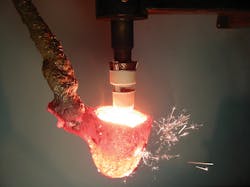SinterCast CGI Starts Year Strong, Up 5.4%
SinterCast AB reported its global series production for compacted graphite iron during January and February 2020 increased 5.4% year-over-year, or a total of 3.1 million "engine equivalents". Each engine equivalent represents 50 kg of CGI, meaning the total produced was 62,000 kg (or 136,686.6 lbs.)
Stockholm-based SinterCast is the developer of a process control package used by foundries to product compacted graphite iron (CGI), a lightweight cast iron that offers greater tensile strength, stiffness, and fatigue strength than gray iron or aluminum. It is mainly used by diesel and gas engine manufacturers seeking to reduce weight, noise, and emissions for their designs.
SinterCast’s CGI process control system is centered on a sampling and testing technology that has been licensed by numerous foundries and research centers worldwide.
SinterCast reported that the start of 2020 has brought new series production activity beyond the cylinder block and head market. In February, Hyundai Motor Group in South Korea started production of a new bedplate for a 3.0-liter, V6 diesel engine. The bedplate, which is matched to a SinterCast-CGI cylinder block, previously had been produced in ductile iron. The conversion to CGI was introduced to improve mold yield and to reduce defect rates in the foundry, and to improve machining productivity.
More recently, in March, SinterCast drew a new order for large components — over 100,000 "engine equivalents" at full production — used in industrial power applications. Series production would begin during the first half of 2020.
The new order would increase SinterCast's base of industrial-power sector customers to 5-10% of the total volume, it noted.
“The start of 2020 has introduced obvious challenges, but also provided new opportunities," according to Dr. Steve Dawson, SinterCast president and CEO. "While the series production may be temporarily influenced by the COVID-19 virus, we remain confident in our long-term growth, both for series production and new installations.”
